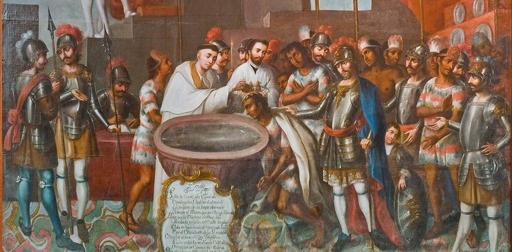Across the United States, the second Monday of October is increasingly becoming known as Indigenous Peoples Day. In the push to rename Columbus Day, Christopher Columbus himself has become a metaphor for the evils of early colonial empires, and rightly so.
Diego Javier Luis
Assistant Professor of History, Johns Hopkins University
October 2, 2024
The Italian explorer who set out across the Atlantic in search of Asia was a notorious advocate for enslaving the Indigenous Taínos of the Caribbean. In the words of historian Andrés Reséndez, he “intended to turn the Caribbean into another Guinea,” the region of West Africa that had become a European slave-trading hub.
By 1506, however, Columbus was dead. Most of the genocidal acts of violence that defined the colonial period were carried out by many, many others. In the long shadow of Columbus, we sometimes lose sight of the ideas, laws and ordinary people who enabled colonial violence on a large scale.
As a historian of colonial Latin America, I often begin such discussions by pointing to a peculiar document drafted several years after Columbus’ death that would have greater repercussions for Indigenous peoples than Columbus himself: the Requerimiento, or “Requirement.”
Catch-22
In 1494, the Treaty of Tordesillas infamously divided much of the world beyond Europe into two halves: one for the Spanish crown, the other for the Portuguese. Spaniards lay claim to almost the entirety of the Americas, though they knew almost nothing about this vast domain or the people who lived there.
In order to inform Indigenous people that they had suddenly become vassals of Spain, King Ferdinand and his councilors instructed colonizers to read the Requerimiento aloud upon first contact with all Indigenous groups.
The document presented them with a choice that was no choice at all. They could either become Christians and submit to the authority of the Catholic Church and the king, or else:
“With the help of God, we shall powerfully enter into your country, and shall make war against you in all ways and manners that we can … we shall take you and your wives and your children and shall make slaves of them … the deaths and losses which shall accrue from this are your fault.”
It was a catch-22. According to the document, Indigenous people could either voluntarily surrender their sovereignty and become vassals or bring war upon themselves – and perhaps lose their sovereignty anyway, after much bloodshed. No matter what they chose, the Requerimiento supplied the legal pretext for forcibly incorporating sovereign Indigenous peoples into the Spanish domain.
At its core, the Requerimiento was a legal ritual, a performance of possession – and it was unique to early Spanish imperialism.
‘As absurd as it is stupid’
But for all of its seeming authority, the reading of the Requerimiento was an absurd exercise. It first occurred at what is now Santa Marta, Colombia, during the expedition led by Pedrarias Dávila in 1513. An eyewitness, the chronicler Gonzalo Fernández de Oviedo, stated the obvious: “we have no one here who can help [the Indigenous people] understand it.”
Even with a translator, though, the document – with its lofty references to the Biblical creation of the world and papal authority – would hardly be intelligible to people unfamiliar with the Spaniards’ religion. Explaining the convoluted document would require nothing less than a long recitation of Catholic history.
Oviedo suggested that to deliver such a lecture, you’d have to first capture and cage an Indigenous person. Even then, it would be impossible to verify whether the document had been fully understood.
However, for the Requerimiento’s greatest critic, Bartolomé de las Casas, translation was merely one of many problems. A missionary from Spain, Las Casas criticized the spurious requirement itself: that a people should be expected to immediately convert to a religion they have only just learned exists, and
“swear allegiance to a king they have never heard of nor clapped eyes on, and whose subjects and ambassadors prove to be cruel, pitiless and bloodthirsty tyrants. … Such a notion is as absurd as it is stupid and should be treated with the disrespect, scorn and contempt it so amply deserves.”
Las Casas, who documented abuses against Indigenous people in multiple books and speeches, was one of the most outspoken denouncers of Spanish cruelty in the Americas. While he believed Spaniards had a right and even an obligation to convert Indigenous people to Catholicism, he did not believe that conversion should be done under the threat of violence.
Illustrations from a book written by Bartolomé de las Casas depicting Spanish torture of Indigenous peoples in the Americas.
Sound familiar? Article from last year, reposted because relevance.



